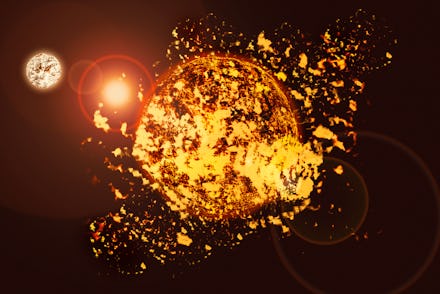Scientists just discovered more about one of the sun's strangest habits

The sun, the major source of life for our solar system, is more than just a burning ball we shouldn't stare at for too long. It's also home to strange phenomena, like "coronal mass ejections." Scientists have observed the sun during several of these events in the past, and recently, thanks to NASA's special Parker Solar Probe, they've been able to make more sense of these happenings. But the most recent measurements researchers were able to pore over regarding these ejections showed something intriguing: a "stealth" ejection that didn't initially reveal much activity at all.
A coronal mass ejection is a fairly regular event that happens when the sun releases plasma as part of the sun's accompanying magnetic field. Said plasma is ejected into the universe as part of solar wind and can be dangerous when it gets near the Earth — it can even enter the Earth's atmosphere and disrupt radio communications
There was a major ejection event back in November 2018, observed by NASA's probe, but it was classified then as what scientists referred to as a "stealth" event. Basically, there were little or no outward signs that it had taken place at all. Initially, the weirdly low-key event baffled researchers. How did something so typically large and monumental happen without any sort of fanfare? But the Parker Solar Probe was flying close to the sun at that point, and gathered more data than was previously possible about the event. Only then were researchers able to glean any new findings from it.
"If you've ever seen a coronal mass ejection image, you normally see a lot of activity in these images," said solar physicist Kelly Korreck, from the Smithsonian Astrophysical Observatory. Speaking during a meeting of the American Astronomical Society in Honolulu, she noted that "you would see a large blowout, you would probably see one of these exploding." However, as attendees saw in the footage captured by the Parker Solar Probe, there just wasn't much going on at all.
There was additional activity the probe captured as well, though, which did confirm the presence of a mass ejection. Because the probe had flown closer to the sun than any prior spacecraft, scientists were able to confirm that the probe had indeed flown through an ejection as it was happening, thanks to the type of data being gathered about the sun's magnetic field. The probe's ability to get up close and personal means that it can help scientists gather important data to study the event more closely in the future. That way, scientists can figure out where coronal mass ejections may originate from on the sun, since it isn't as simple as just taking a closer look, obviously.
"They're something that we're not traditionally able to see in the ways that we've previously detected coronal mass ejections," Korreck explained. "We're starting to see hints of them with better and better telescope resolution. However, at the same time, we've kind of reached the end where we actually have to go in situ to do a better measurement."
It's important that scientists get a better handle on this phenomenon going forward, since these coronal mass ejections are not totally harmless. They can affect satellites orbiting Earth, communications, and even future space travel. Thus, figuring out more about them, how they happen, and where they originate from is an important part of scientists' research for the moment. "Perfect" research techniques for the ejections are still a ways off, but thanks to the probe, it looks like we're in for some important developments very soon.